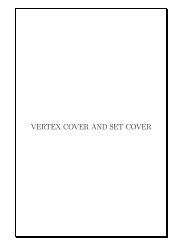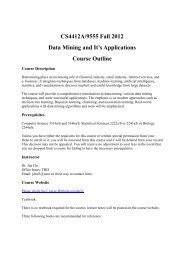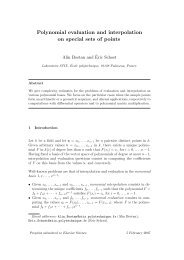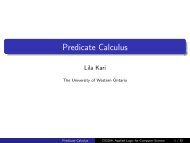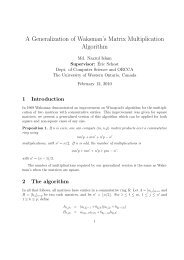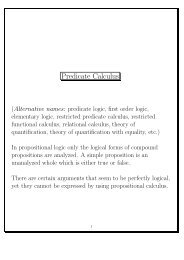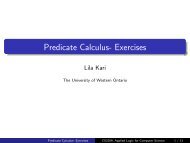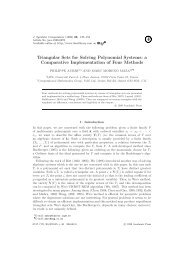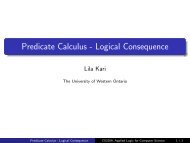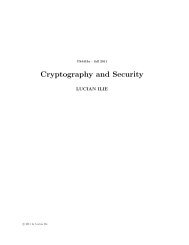Interactive Segmentation with Super-Labels - University of Western ...
Interactive Segmentation with Super-Labels - University of Western ...
Interactive Segmentation with Super-Labels - University of Western ...
You also want an ePaper? Increase the reach of your titles
YUMPU automatically turns print PDFs into web optimized ePapers that Google loves.
2 A. Delong, L. Gorelick, F. R. Schmidt, O. Veksler and Y. Boykovuser scribbles1 2propose models fromcurrent super-labelingsolve 2-level MRF converged to finalvia α-expansionsub-labelingE=503005 E=4522883 re-estimate all sub-modelsFig. 2. We iteratively propose new models by randomly sampling pixels from superlabels,optimize the resulting two-level MRF, and re-estimate model parameters.We propose a novel energy that unifies these two approaches by incorporatingunsupervised learning into interactive segmentation. We show that thismore descriptive object model leads to better high-level segmentations. In ourformulation, each object (super-label) is automatically decomposed into spatiallycoherent regions where each region is described by a distinct appearance model(sub-label). This results in a two-level MRF <strong>with</strong> super-labels at the top level thatare partitioned into sub-labels at the bottom. Figure 1 illustrates the main idea.We introduce the hierarchical Potts (hPotts) prior to govern spatial coherenceat both levels <strong>of</strong> our MRF. The hierarchical Potts prior regularizes boundariesbetween objects (super-label transitions) differently from boundaries <strong>with</strong>in eachobject (sub-label transitions). The unsupervised aspect <strong>of</strong> our MRF allows appearancemodels <strong>of</strong> arbitrary complexity and would severely over-fit the imagedata if left unregularized. We address this by incorporating global sparsity priorinto our MRF via the energetic concept <strong>of</strong> “label costs” [7].Since our framework is based on multi-label MRFs, a natural choice <strong>of</strong> optimizationmachinery is α-expansion [11, 7]. Furthermore, the number, class, andparameters <strong>of</strong> each object’s appearance models are not known a priori — in orderto use powerful combinatorial techniques we must propose a finite set <strong>of</strong> possibilitiesfor α-expansion to select from. We therefore resort to an iterative graph-cutprocess that involves random sampling to propose new models, α-expansion toupdate the segmentation, and re-estimation to improve the current appearancemodels. Figure 2 illustrates our algorithm.The remainder <strong>of</strong> the paper is structured as follows. Section 2 discusses othermethods for modeling complex appearance, MDL-based segmentation, and relatediterative graph-cut algorithms. Section 3 describes our energy-based formulationand algorithm in formal detail. Section 4 shows applications in interactivebinary/multi-class segmentation and interactive co-segmentation; furthermore itdescribes how our framework easily allows appearance models to come from amixture <strong>of</strong> classes (GMM, plane, etc.). Section 5 draws an interesting parallelbetween our formulation and multi-class semi-supervised learning in general.2 Related WorkComplex appearance models. The DDMCMC method [6] was the first toemphasize the importance <strong>of</strong> representing object appearance <strong>with</strong> complex mod-
<strong>Interactive</strong> <strong>Segmentation</strong> <strong>with</strong> <strong>Super</strong>-<strong>Labels</strong> 3els (e.g. splines and texture based models in addition to GMMs) in the context<strong>of</strong> unsupervised segmentation. However, being unsupervised, DDMCMC doesnot delineate objects but rather provides low-level segments along <strong>with</strong> their appearancemodels. Ours is the first multi-label graph-cut based framework thatcan learn a mixture <strong>of</strong> such models for segmentation.There is an interactive method [10] that decomposes objects into spatiallycoherent sub-regions <strong>with</strong> distinct appearance models. However, the number <strong>of</strong>sub-regions, their geometric interactions, and their corresponding appearancemodels must be carefully designed for each object <strong>of</strong> interest. In contrast, weautomatically learn the number <strong>of</strong> sub-regions and their model parameters.MDL-based segmentation. A number <strong>of</strong> works have shown that minimumdescription length (MDL) is a useful regularizer for unsupervised segmentation,e.g. [5–7]. Our work stands out here in two main respects: our formulationis designed for semi-supervised settings and explicitly weighs the benefit <strong>of</strong> eachappearance model against the ‘cost’ <strong>of</strong> its inherent complexity (e.g. number <strong>of</strong>parameters). To the best <strong>of</strong> our knowledge, only the unsupervised DDMCMC [6]method allows arbitrary complexity while explicitly penalizing it in a meaningfulway. However, they use a completely different optimization framework and,being unsupervised, they do not delineate object boundaries.Iterative graph-cuts. Several energy-based methods have employed EM-stylealternation between a graph-cut/α-expansion phase and a model re-estimationphase, e.g. [12, 2, 13, 14, 7]. Like our work, Grab-Cut [2] is about interactive segmentation,though their focus is binary segmentation <strong>with</strong> a bounding-box interactionrather than scribbles. The bounding box is intuitive and effective formany kinds <strong>of</strong> objects but <strong>of</strong>ten requires subsequent scribble-based interactionfor more precise control. Throughout this paper, we compare our method toan iterative multi-label variant <strong>of</strong> Boykov-Jolly [1] that we call iBJ. Given userscribbles, this baseline method maintains one GMM per object label and iteratesbetween α-expansion and re-estimating each model.On an algorithmic level, the approach most closely related to ours is the unsupervisedmethod [14, 7] because it also involves random sampling, α-expansion,and label costs. Our framework is designed to learn complex appearance modelsfrom partially-labeled data and differs from [14, 7] in the following respects:(1) we make use <strong>of</strong> hard constraints and the current super-labeling to guide randomsampling, (2) our hierarchical Potts potentials regularize sub- and superlabelsdifferently, and (3), again, our label costs penalize models based on theirindividual complexity rather than using uniform label costs.3 Modeling Complex Appearance via <strong>Super</strong>-<strong>Labels</strong>We begin by describing a novel multi-label energy that corresponds to our twolevelMRF. Unlike typical MRF-based segmentation methods, our actual set<strong>of</strong> discrete labels (appearance models) is not precisely known beforehand andwe need to estimate both the number <strong>of</strong> unique models and their parameters.Section 3.1 explains this energy formulation in detail, and Section 3.2 describesour iterative algorithm for minimizing this energy.
<strong>Interactive</strong> <strong>Segmentation</strong> <strong>with</strong> <strong>Super</strong>-<strong>Labels</strong> 5c 2 encourages smoothness among super-labels. This potential is a special case <strong>of</strong>our more general class <strong>of</strong> hierarchical Potts potentials introduced in Appendix 7,but two-level Potts is sufficient for our interactive segmentation applications.For image segmentation we assume c 1 ≤ c 2 , though in general any V <strong>with</strong>c 1 ≤ 2c 2 is still a metric [11] and can be optimized by α-expansion. Appendix 7gives general conditions for hPotts to be metric. It is commonly known thatsmoothness costs directly affect the expected length <strong>of</strong> the boundary and shouldbe scaled proportionally to the size <strong>of</strong> the image. Intuitively c 2 should be largeras it operates on the entire image as opposed to smaller regions that correspondto objects. The weight w pq ≥ 0 <strong>of</strong> each pairwise term in (1) is computed fromlocal image gradients in the standard way (e.g. [1, 2]).Finally, we incorporate a model-dependent “label costs” [7] to regularize thenumber <strong>of</strong> unique models in L and their individual complexity. A label cost h lis a global potential that penalizes the use <strong>of</strong> l in labeling f through indicatorfunction δ l (f) = 1 ⇔ ∃f p = l. There are many possible ways to define the weighth l <strong>of</strong> a label cost, such as Akaike information criterion (AIC) [16] or Bayesianinformation critierion (BIC) [17]. We use a heuristic described in Section 4.2.3.2 Our SUPERLABELSEG AlgorithmWe propose a novel segmentation algorithm based on the iterative Pearl framework[7]. Each iteration <strong>of</strong> Pearl has three main steps: propose candidatemodels by random sampling, segment via α-expansion <strong>with</strong> label costs, andre-estimate the model parameters for the current segmentation. Our algorithmdiffers from [7] as follows: (1) we make use <strong>of</strong> hard constraints g and the currentsuper-labeling π ◦ f to guide random sampling, (2) our two-level Potts potentialsregularize sub- and super-labels differently, and (3) our label costs penalizemodels based on their individual complexity rather than uniform penalty.The proposal step repeatedly generates a new candidate model l <strong>with</strong> parametersθ l fitted to a random subsample <strong>of</strong> pixels. Each model is proposed in thecontext <strong>of</strong> a particular super-label i ∈ S, and so the random sample is selectedfrom the set <strong>of</strong> pixels P i = { p | π(f p ) = i } currently associated <strong>with</strong> i. Eachcandidate l is then added to the current label set L <strong>with</strong> super-label assignmentset to π(l) = i. A heuristic is used to determine a sufficient number <strong>of</strong> proposalsto cover the set <strong>of</strong> pixels P i at each iteration.Once we have candidate sub-labels for every object a naïve approach wouldbe to directly optimize our two-level MRF. However, being random, not all <strong>of</strong> anobject’s proposals are equally good for representing its appearance. For example,a proposal from a small sample <strong>of</strong> pixels is likely to over-fit or mix statistics(Figure 3, proposal 2). Such models are not characteristic <strong>of</strong> the object’s overallappearance but are problematic because they may incidentally match some portion<strong>of</strong> another object and lead to an erroneous super-label segmentation. Beforeallowing sub-labels to compete over the entire image, we should do our best toensure that all appearance models <strong>with</strong>in each object are relevant and accurate.Given the complete set <strong>of</strong> proposals, we first re-learn the appearance <strong>of</strong> eachobject i ∈ S. This is achieved by restricting our energy to pixels that are currentlylabeled <strong>with</strong> π(f p ) = i and optimizing via α-expansion <strong>with</strong> label costs [7];
6 A. Delong, L. Gorelick, F. R. Schmidt, O. Veksler and Y. BoykovGMM for 1GMM for 2GMM for 3123graywhitegraywhitegraynot an accurate appearance model for red scribble!whiteFig. 3. The object marked <strong>with</strong> red has two spatially-coherent appearances: pure gray,and pure white. We can generate proposals for the red object from random patches1–3. However, if we allow proposal 2 to remain associated <strong>with</strong> the red object, it mayincorrectly claim pixels from the blue object which actually does look like proposal 2.this ensures that each object is represented by an accurate set <strong>of</strong> appearancemodels. Once each object’s appearance has been re-learned, we allow the objectsto simultaneously compete for all image pixels while continuing to re-estimatetheir parameters. <strong>Segmentation</strong> is performed on a two-level MRF defined by thecurrent (L, θ, π). Again, we use α-expansion <strong>with</strong> label costs to select a goodsubset <strong>of</strong> appearance models and to partition the image. The pseudo-code belowdescribes our <strong>Super</strong>LabelSeg algorithm.<strong>Super</strong>LabelSeg(g) where g : P → S ∪ {none} is a partial labeling1 L = {} // empty label set <strong>with</strong> global f, π, θ undefined2 Propose(g) // initialize L, π, θ from user scribbles3 repeat4 Segment(P, L) // segment entire image using all available labels L5 Propose(π ◦f) // update L, π, θ from current super-labeling6 until convergedPropose(z) where z : P → S ∪ {none}1 for each i ∈ S2 P i = { p | z p = i } // set <strong>of</strong> pixels currently labeled <strong>with</strong> super-label i3 repeat sufficiently4 generate model l <strong>with</strong> parameters θ l fitted to random sample from P i5 π(l) = i6 L = L ∪ {l}7 end8 L i = { l | π(l) = i }9 Segment(P i , L i ) // optimize models and segmentation <strong>with</strong>in super-label iSegment( ˆP, ˆL) where ˆP ⊆ P and ˆL ⊆ L1 let f| ˆPdenote current global labeling f restricted to ˆP2 repeat3 f| ˆP= argmin ˆfE( ˆL, θ, π, ˆf) // segment by α-expansion <strong>with</strong> label costs [7]4 // where we optimize only on ˆf : ˆP → ˆL5 L= L \ { l ∈ ˆL | δ l ( ˆf) = 0} // discard unused models6 θ = argmin θ E( ˆL, θ, π, ˆf) // re-estimate each sub-model params7 until converged
<strong>Interactive</strong> <strong>Segmentation</strong> <strong>with</strong> <strong>Super</strong>-<strong>Labels</strong> 7user scribbles sub-labeling our appearance models our segmentation iBJ segmentationFig. 4. Binary segmentation examples. The second column shows our final sub-labelsegmentation f where blues indicate foreground sub-labels and reds indicate backgroundsub-labels. The third column is generated by sampling each I p from model θ fp .The last two columns compare our super-label segmentation π ◦f and iBJ.4 Applications and ExperimentsOur experiments demonstrate the conceptual and qualitative improvement thata two-level MRF can provide. We are only concerned <strong>with</strong> scribble-based MRFsegmentation, an important class <strong>of</strong> interactive methods. We use an iterativevariant <strong>of</strong> Boykov-Jolly [1] (iBJ) as a representative baseline because it is simple,popular, and exhibits a problem characteristic to a wide class <strong>of</strong> standardmethods. By using one appearance model per object, such methods implicitlyassume that pixels <strong>with</strong>in each object are i.i.d. <strong>with</strong> respect to its model. However,this is rarely the case, as objects <strong>of</strong>ten have multiple distinct appearancesand exhibit strong spatial correlation among their pixels. The main message <strong>of</strong>all the experiments is to show that by using multiple distinctive appearancemodels per object we are able to reduce uncertainty near the boundaries <strong>of</strong> objectsand thereby improve segmentation in difficult cases. We show applicationsin interactive binary/multi-class segmentation and interactive co-segmentation.Implementation details: In all our experiments we used publicly availableα-expansion code [11, 7, 4, 18]. Our non-optimized matlab implementation takeson the order <strong>of</strong> one to three minutes depending on the size <strong>of</strong> the image, <strong>with</strong>the majority <strong>of</strong> time spent on re-estimating the sub-model parameters. We usedthe same <strong>with</strong>in- and between- smoothness costs (c 1 = 5, c 2 = 10) in all binary,multi-class and co-segmentation experiments. Our proposal step uses distancebasedsampling <strong>with</strong>in each super-label whereby patches <strong>of</strong> diameter 3 to 5are randomly selected. For re-estimating model parameters we use the Matlabimplementation <strong>of</strong> EM algorithm for GMMs and we use PCA for planes. Weregularize GMM covariance matrices to avoid overfitting in (L, a, b) color spaceby adding constant value <strong>of</strong> 2.0 to the diagonal.4.1 Binary <strong>Segmentation</strong>For binary segmentation we assume that the user wishes to segment an objectfrom the background where the set <strong>of</strong> super-labels (scribble indexes) is definedby S = {F, B}. In this specific case we found that most <strong>of</strong> the user interaction isspent on removing disconnected false-positive object regions by scribbling overthem <strong>with</strong> background super-label. We therefore employ a simple heuristic: after
8 A. Delong, L. Gorelick, F. R. Schmidt, O. Veksler and Y. Boykovuser scribbles ours iBJFig. 5. More binary segmentation results showing scribbles, sub-labelings, synthesizedimages, and final cut-outs.iBJoursGMMsoursplaneFig. 6. An image exhibiting gradual changes in color. Columns 2–4 show colors sampledfrom the learned appearance models for iBJ, our two-level MRF restricted to GMMsonly, and ours <strong>with</strong> both GMMs and planes. Our framework can detect a mix <strong>of</strong> GMMs(grass,clouds) and planes (sky) for the background super-label (top-right).convergence we find foreground connected components that are not supported bya scribble and modify their data-terms to prohibit those pixels from taking thesuper-label F . We then perform one extra segmentation step to account for thenew constraints. We apply this heuristic in all our binary segmentation results forboth <strong>Super</strong>LabelSeg and iBJ (Figures 4, 5, 6). Other heuristics could be easilyincorporated in our energy to encourage connectivity, e.g. star-convexity [19, 20].In Figure 4, top-right, notice that iBJ does not incorporate the floor as part<strong>of</strong> the background. This is because there is only a small proportion <strong>of</strong> floor pixelsin the red scribbles, but a large proportion <strong>of</strong> a similar color (ro<strong>of</strong>) in the bluescribbles. By relying directly on the color proportions in the scribbles, the learnedGMMs do not represent the actual appearance <strong>of</strong> the objects in the full image.Therefore the ground is considered a priori more likely to be explained by the(wrong) ro<strong>of</strong> color than the precise floor color, giving an erroneous segmentationdespite the hard constraints. Our methods relies on spatial coherence <strong>of</strong> thedistinct appearances <strong>with</strong>in each object and therefore has a sub-label that fitsthe floor color tightly. This same phenomenon is even more evident in the bottomrow <strong>of</strong> Figure 5. In the iBJ case, the appearance model for the foreground mixesthe statistics from all scribbled pixels and is biased towards the most dominantcolor. Our decomposition allows each appearance <strong>with</strong> spatial support (texturedfabric, face, hair) to have good representation in the composite foreground model.
<strong>Interactive</strong> <strong>Segmentation</strong> <strong>with</strong> <strong>Super</strong>-<strong>Labels</strong> 9iBJours, GMM onlyours, GMM + planesGMMGMMGMMGMM GMMplaneplaneGMM2 planesdetectedGMMdetectedFig. 7. Our algorithm detects complex mixtures <strong>of</strong> models, .for example GMMs and planes. The appearance <strong>of</strong> the above y.xobject cannot be captured by GMMs alone.black white4.2 Complex Appearance ModelsIn natural images objects <strong>of</strong>ten exhibit gradual change in hue, tone or shades.Modeling an object <strong>with</strong> a single GMM in color space [1, 2] makes the implicitassumption that appearance is piece-wise constant. In contrast, our frameworkallows us to decompose an object into regions <strong>with</strong> distinct appearance models,each from an arbitrary class (e.g. GMM, plane, quadratic, spline). Our algorithmwill choose automatically the most suitable class for each sub-label <strong>with</strong>in anobject. Figure 6 (right) shows such an example where the background is decomposedinto several grass regions, each modeled by a GMM in (L, a, b) color space,and a sky region that is modeled by a plane 3 in a 5-dimensional (x, y, L, a, b)space. Note the gradual change in the sky color and how the clouds are segmentedas a separate ‘white’ GMM.Figure 7 show a synthetic image, in which the foreground object breaks intotwo sub-regions, each exhibiting a different type <strong>of</strong> gradual change in color. Thiskind <strong>of</strong> object appearance cannot be captured by a mixture <strong>of</strong> GMM models.In general our framework can incorporate a wide range <strong>of</strong> appearance modelsas long as there exists a black-box algorithm for estimating the parameters θ l ,which can be used at the line 6 <strong>of</strong> Segment. The importance <strong>of</strong> more complexappearance models was proposed by DDMCMC [6] for unsupervised segmentationin a completely different algorithmic framework. Ours is the first multi-labelgraph-cut based framework that can incorporate such models.Because our appearance models may be arbitrarily complex, we must incorporateindividual model complexity in our energy. Each label cost h l is computedbased on the number <strong>of</strong> parameters θ l and the number ν <strong>of</strong> pixels that are tobe labeled, namely h l = 1 2√ ν|θl |. We set ν = #{ p | g p ≠ none } for line 2 <strong>of</strong> the<strong>Super</strong>LabelSeg algorithm and ν = |P| for lines 4,5. Penalizing complexity isa crucial part <strong>of</strong> our framework because it helps our MRF-based models to avoidover-fitting. Label costs balance the number <strong>of</strong> parameters required to describethe models against the number <strong>of</strong> data points to which the models are fit. Whenre-estimating the parameters <strong>of</strong> a GMM we allow the number <strong>of</strong> components toincrease or decrease if favored by the overall energy.4.3 Multi-Class <strong>Segmentation</strong><strong>Interactive</strong> multi-class segmentation is a straight-forward application <strong>of</strong> our energy(1) where the set <strong>of</strong> super-labels S contains an index for each scribble color.3 In color images a ‘plane’ is a 2-D linear subspace (a 2-flat) <strong>of</strong> a 5-D image space.
10 A. Delong, L. Gorelick, F. R. Schmidt, O. Veksler and Y. Boykovuser scribbles our sub-labeling our models iBJ labeling iBJ modelsFig. 8. Multi-class segmentation examples. Again, we show the color-coded sublabelingsand the learned appearance models. Our super-labels are decomposed intospatially coherent regions <strong>with</strong> distinct appearance.Figure 8 shows examples <strong>of</strong> images <strong>with</strong> multiple scribbles corresponding to multipleobjects. The resulting sub-labelings show how objects are decomposed intoregions <strong>with</strong> distinct appearances. For example, in the top row, the basket isdecomposed into a highly-textured colorful region (4-component GMM) and amore homogeneous region adjacent to it (2-component GMM). In the bottomrow, notice that the hair <strong>of</strong> children marked <strong>with</strong> blue was so weak in the iBJ appearancemodel that it was absorbed into the background. The synthesized imagessuggest the quality <strong>of</strong> the learned appearance models. Unlike the binarycase, here we do not apply the post-processing step enforcing connectivity.4.4 <strong>Interactive</strong> Co-segmentationOur two-level MRFs can be directly used for interactive co-segmentation [3, 21].Specifically, we apply our method to co-segmentation <strong>of</strong> a collection <strong>of</strong> similarimages as in [3] because it is a natural scenario for many users. This differs from‘unsupervised’ binary co-segmentation [8, 9] that assumes dissimilar backgroundsand similar-sized foreground objects. Figure 9 shows a collection <strong>of</strong> four images<strong>with</strong> similar content. Just by scribbling on one <strong>of</strong> the images our method isable to correctly segment the objects. Note that the unmarked images containbackground colors not present in the scribbled image, yet our method was ableto detect these novel appearances and correctly segment the background intosub-labels.5 Discussion: <strong>Super</strong>-<strong>Labels</strong> as Semi-<strong>Super</strong>vised LearningThere are evident parallels between interactive segmentation and semi-supervisedlearning, particularly among graph cut methods ([1] versus [22]) and randomwalk methods ([23] versus [24]). An insightful paper by Duchenne et al. [25]explicitly discusses this observation. Looking back at our energy and algorithmfrom this perspective, it is clear that we actually do semi-supervised learning appliedto image segmentation. For example, the grayscale image in Figure 7 can bevisualized as points in a 3D feature space where small subsets <strong>of</strong> points have beenlabeled either blue or red. In addition to making ‘transductive’ inferences, ouralgorithm automatically learned that the blue label is best decomposed into two
<strong>Interactive</strong> <strong>Segmentation</strong> <strong>with</strong> <strong>Super</strong>-<strong>Labels</strong> 11image collection our co-segmentation iBJ co-segmentationFig. 9. <strong>Interactive</strong> co-segmentation examples. Note that our method detected submodelsfor grass, water, and sand in the 1 st and 3 rd bear images; these appearanceswere not present in the scribbled image.linear subspaces (green & purple planes in Figure 7, right) whereas the red labelis best described by a single bi-modal GMM. The number, class, and parameters<strong>of</strong> these models was not known a priori but was discovered by <strong>Super</strong>LabelSeg.Our two-level framework allows each object to be modeled <strong>with</strong> arbitrarycomplexity but, crucially, we use spatial coherence (smooth costs) and labelcosts to regularize the energy and thereby avoid over-fitting. Setting c 1 < c 2 inour smooth costs V corresponds to a “two-level clustering assumption,” i.e. thatclass clusters are better separated than the sub-clusters <strong>with</strong>in each class. Tothe best <strong>of</strong> our knowledge, we are first to suggest iterated random samplingand α-expansion <strong>with</strong> label costs (<strong>Super</strong>LabelSeg) as an algorithm for multiclasssemi-supervised learning. These observations are interesting and potentiallyuseful in the context <strong>of</strong> more general semi-supervised learning.6 ConclusionIn this paper we raised the question <strong>of</strong> whether GMM/histograms are an appropriatechoice for modeling object appearance. If GMMs and histograms are notsatisfying generative models for a natural image, they are equally unsatisfyingfor modeling appearance <strong>of</strong> complex objects <strong>with</strong>in the image.To address this question we introduced a novel energy that models complexappearance as a two-level MRF. Our energy incorporates both elements<strong>of</strong> interactive segmentation and unsupervised learning. Interactions are used to
12 A. Delong, L. Gorelick, F. R. Schmidt, O. Veksler and Y. Boykovprovide high-level knowledge about objects in the image, whereas the unsupervisedcomponent tries to learn the number, class and parameters <strong>of</strong> appearancemodels <strong>with</strong>in each object. We introduced the hierarchical Potts prior to regularizesmoothness <strong>with</strong>in and between the objects in our two-level MRF, and weuse label costs to account for the individual complexity <strong>of</strong> appearance models.Our experiments demonstrate the conceptual and qualitative improvement thata two-level MRF can provide.Finally, our energy and algorithm have interesting interpretations in terms <strong>of</strong>semi-supervised learning. In particular, our energy-based framework can be extendedin a straight-forward manner to handle general semi-supervised learning<strong>with</strong> ambiguously-labeled data [26]. We leave this as future work.7 Appendix — Hierarchical PottsIn this paper we use two-level Potts potentials where the smoothness is governedby two coefficients, c 1 and c 2 . This concept can be generalized to a hierarchicalPotts (hPotts) potential that is useful whenever there is a natural hierarchicalgrouping <strong>of</strong> labels. For example, the recent work on hierarchical context [27]learns a tree-structured grouping <strong>of</strong> the class labels for object detection; <strong>with</strong>hPotts potentials it is also possible to learn pairwise interactions for segmentation<strong>with</strong> hierarchical context. We leave this as future work.We now characterize our class <strong>of</strong> hPotts potentials and prove necessary andsufficient conditions for them to be optimized by the α-expansion algorithm [11].Let N = L∪S denote combined set <strong>of</strong> sub-labels and super-labels. A hierarchicalPotts prior V is defined <strong>with</strong> respect to an irreducible 4 tree over node set N . Theparent-child relationship in the tree is determined by π : N → S where π(l) givesthe parent 5 <strong>of</strong> l. The leaves <strong>of</strong> the tree are the sub-labels L and the interior nodesare the super-labels S. Each node i ∈ S has an associated Potts coefficient c i forpenalizing sub-label transitions that cross from one sub-tree <strong>of</strong> i to another. AnhPotts potential is a special case <strong>of</strong> general pairwise potentials over L and can bewritten as an |L|×|L| “smooth cost matrix” <strong>with</strong> entries V (l, l ′ ). The coefficients<strong>of</strong> this matrix are block-structured in a way that corresponds to some irreducibletree. The example below shows an hPotts potential V and its corresponding tree.V(l, l ′ )0 c 1c 5c 1000 c 2 c4c2 0c 5c 40 c 3c 3 0⇔1sub-labels L5super-labels S42 3α β γLet π n (l) denote n applications <strong>of</strong> the parent function as in π(· · · π(l)). Letlca(l, l ′ ) denote the lowest common ancestor <strong>of</strong> l and l ′ , i.e. lca(l, l ′ ) = i where4 A tree is irreducible if all its internal nodes have at least two children.5 The root <strong>of</strong> the tree r ∈ S is assigned π(r) = r.
<strong>Interactive</strong> <strong>Segmentation</strong> <strong>with</strong> <strong>Super</strong>-<strong>Labels</strong> 13i = π n (l) = π m (l ′ ) for minimal n, m. We can now define an hPotts potential asV (l, l ′ ) = c lca(l,l ′ ) (4)where we assume V (l, l) = c l = 0 for each leaf l ∈ L. For example, in the treeillustrated above lca(α, β) is super-label 4 and so the smooth cost V (α, β) = c 4 .Theorem 1. Let V be an hPotts potential <strong>with</strong> corresponding irreducible tree π.V is metric on L ⇐⇒ c i ≤ 2c j for all j = π n (i). (5)Pro<strong>of</strong>. The metric constraint V (β, γ) ≤ V (α, γ) + V (β, α) is equivalent toc lca(β,γ) ≤ c lca(α,γ) + c lca(β,α) (6)for all α, β, γ ∈ L. Because π defines a tree structure, for every α, β, γ thereexists i, j ∈ S such that, <strong>with</strong>out loss <strong>of</strong> generality,j = lca(α, γ) = lca(β, α), andi = lca(β, γ) such that j = π k (i) for some k ≥ 0.(7)In other words there can be up to two unique lowest common ancestors among(α, β, γ) and we assume ancestor i is in the sub-tree rooted at ancestor j, possiblyequal to j. For any particular (α, β, γ) and corresponding (i, j) inequality (6) isequivalent to c i ≤ 2c j . Since π defines an irreducible tree, for each (i, j) theremust exist corresponding sub-labels (α, β, γ) for which (6) holds. It follows thatc i ≤ 2c j holds for all pairs j = π k (i) and completes the pro<strong>of</strong> <strong>of</strong> (5). References1. Boykov, Y., Jolly, M.P.: <strong>Interactive</strong> Graph Cuts for Optimal Boundary and Region<strong>Segmentation</strong> <strong>of</strong> Objects in N-D Images. Int’l Conf. on Computer Vision (ICCV)1 (2001) 105–1122. Rother, C., Kolmogorov, V., Blake, A.: GrabCut: <strong>Interactive</strong> Foreground Extractionusing Iterated Graph Cuts. In: ACM SIGGRAPH. (2004)3. Batra, D., Kowdle, A., Parikh, D., Luo, J., Chen, T.: iCoseg: <strong>Interactive</strong> Cosegmentation<strong>with</strong> Intelligent Scribble Guidance. In: IEEE Conf. on ComputerVision and Pattern Recognition (CVPR). (2010)4. Kolmogorov, V., Zabih, R.: What Energy Functions Can Be Optimized via GraphCuts. IEEE Trans. on Patt. Analysis and Machine Intelligence 26 (2004) 147–1595. Zhu, S.C., Yuille, A.L.: Region competition: unifying snakes, region growing, andBayes/MDL for multiband image segmentation. IEEE Trans. on Pattern Analysisand Machine Intelligence 18 (1996) 884–9006. Tu, Z., Zhu, S.C.: Image <strong>Segmentation</strong> by Data-Driven Markov Chain Monte Carlo.IEEE Trans. on Pattern Analysis and Machine Intelligence 24 (2002) 657–6737. Delong, A., Osokin, A., Isack, H., Boykov, Y.: Fast Approximate Energy Minimization<strong>with</strong> Label Costs. Int’l Journal <strong>of</strong> Computer Vision (2011) (in press).
14 A. Delong, L. Gorelick, F. R. Schmidt, O. Veksler and Y. Boykov8. Rother, C., Minka, T., Blake, A., Kolmogorov, V.: Cosegmentation <strong>of</strong> Image Pairsby Histogram Matching - Incorporating a Global Constraint into MRFs. In: IEEEConf. on Computer Vision and Pattern Recognition (CVPR). (2006)9. Vicente, S., Kolmogorov, V., Rother, C.: Cosegmentation Revisited: Models andOptimization. In: European Conf. on Computer Vision (ECCV). (2010)10. Delong, A., Boykov, Y.: Globally Optimal <strong>Segmentation</strong> <strong>of</strong> Multi-Region Objects.In: Int’l Conf. on Computer Vision (ICCV). (2009)11. Boykov, Y., Veksler, O., Zabih, R.: Fast Approximate Energy Minimization viaGraph Cuts. IEEE Trans. on Pattern Analysis and Machine Intelligence (2001)12. Birchfield, S., Tomasi, C.: Multiway cut for stereo and motion <strong>with</strong> slanted surfaces.In: Int’l Conf. on Computer Vision. (1999)13. Zabih, R., Kolmogorov, V.: Spatially Coherent Clustering <strong>with</strong> Graph Cuts. In:IEEE Conf. on Computer Vision and Pattern Recognition (CVPR). (2004)14. Isack, H.N., Boykov, Y.: Energy-based Geometric Multi-Model Fitting. Int’l Journal<strong>of</strong> Computer Vision (2011) (accepted).15. Lafferty, J., McCallum, A., Pereira, F.: Conditional random fields: Probabilisticmodels for segmenting and labeling sequence data. In: Int’l Conf. on MachineLearning (ICML). (2001)16. Akaike, H.: A new look at statistical model identification. IEEE Trans. on AutomaticControl 19 (1974) 716–72317. Schwarz, G.: Estimating the Dimension <strong>of</strong> a Model. Annals <strong>of</strong> Statistics 6 (1978)461–64618. Boykov, Y., Kolmogorov, V.: An Experimental Comparison <strong>of</strong> Min-Cut/Max-FlowAlgorithms for Energy Minimization in Vision. IEEE Trans. on Pattern Analysisand Machine Intelligence 29 (2004) 1124–113719. Veksler, O.: Star Shape Prior for Graph-Cut Image <strong>Segmentation</strong>. In: EuropeanConf. on Computer Vision (ECCV). (2008)20. Gulshan, V., Rother, C., Criminisi, A., Blake, A., Zisserman, A.: Geodesic StarConvexity for <strong>Interactive</strong> Image <strong>Segmentation</strong>. In: IEEE Conf. on Computer Visionand Pattern Recognition (CVPR). (2010)21. Schnitman, Y., Caspi, Y., Cohen-Or, D., Lischinski, D.: Inducing Semantic <strong>Segmentation</strong>from an Example. In: Asian Conf. on Computer Vision (ACCV). (2006)22. Blum, A., Chawla, S.: Learning from labeled and unlabeled data using graphmincuts. In: Int’l Conf. on Machine Learning. (2001)23. Grady, L.: Random Walks for Image <strong>Segmentation</strong>. IEEE Trans. on PatternAnalysis and Machine Intelligence 28 (2006) 1768–178324. Szummer, M., Jaakkola, T.: Partially labeled classication <strong>with</strong> markov randomwalks. In: Advances in Neural Information Processing Systems (NIPS). (2001)25. Duchenne, O., Audibert, J.Y., Keriven, R., Ponce, J., Segonne, F.: <strong>Segmentation</strong>by transduction. In: IEEE Conf. on Computer Vision and Pattern Recognition(CVPR). (2008)26. Cour, T., Sapp, B., Jordan, C., Taskar, B.: Learning from Ambiguously LabeledImages. In: IEEE Conf. on Computer Vision and Pattern Recognition (CVPR).(2009)27. Choi, M.J., Lim, J., Torralba, A., Willsky, A.S.: Exploiting Hierarchical Contexton a Large Database <strong>of</strong> Object Categories. In: IEEE Conf. on Computer Visionand Pattern Recognition (CVPR). (2010)



